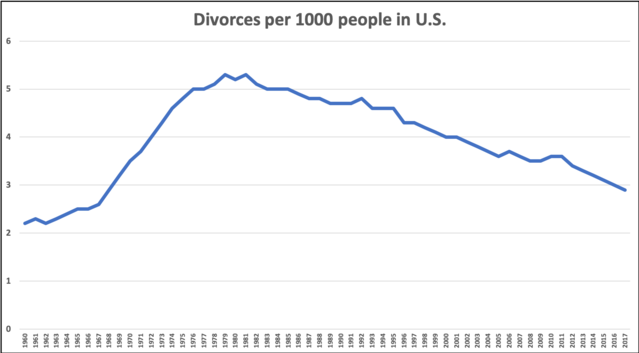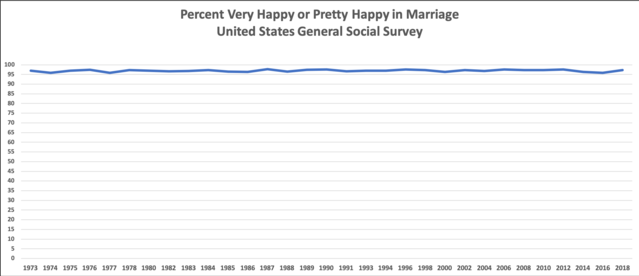Divorce
How’s the Flight? Marital Happiness and Divorce
Plane flights can explain a paradox about marital happiness and divorce.
Posted October 2, 2019 Reviewed by Hara Estroff Marano

While many couples divorce, most people report being happily married when surveyed. Those facts seem at odds. There are some methodological explanations for this paradox, but I have long thought about it using the metaphor of an airplane in flight.
University of Utah sociologist Nicholas Wolfinger tells me the divorce rate has been increasing for over 500 years; however, I am focusing on a shorter period of history. In the U. S., divorce skyrocketed in the 1960s.[i] The chart below, based on the crude divorce rate per 1000, nicely portrays the change (and how it has declined from the highest point, in 1981).

Contrast that with this chart that depicts the percent of married people who said their marriage was either “very happy” or “pretty happy” in data from the U.S. General Social Survey.[ii] Only a tiny percent reported being “not too happy.”

The divorce data and happiness data are fundamentally different. The divorce data are official statistics for the entire country; they are population-level data of couple outcomes. Marital happiness ratings are individual-level data from cross-sectional surveys that reflect sentiments when surveyed. There are methodological and conceptual differences in these types of data. Still, the two facts seem paradoxical. To many, it is not obvious how divorce can be common while most people report being happily married.[iii]
Taking Flight
Most airplanes, most of the time, are flying high in the air (somewhere above 30,000 feet). That, however, does not represent the trajectory of entire flights. Similarly, the chart above does not show trajectories of happiness across time in marriages. Many people who reported being happy in their marriage when surveyed will eventually divorce. That’s the primary cause of the paradox, I think.
I have long imagined marital trajectories as airplane flights. In my metaphor, altitude is happiness and crashes are divorces. Some divorces may be better typified as landings short of the original destination, but let’s keep things simple for the metaphor. Here, a crash pertains to a terminated marriage.
Long flight, high altitude, no major malfunctions, safe landing. That’s a long-term, happily married couple completing the flight most marrying couples hope to fly. The plane may navigate a thunderstorm or two—and all flights have some turbulence—but it’s mostly steady flying. Paul Amato and Spencer James published a paper in 2018 that describes these couples, showing that most lasting marriages are quite happy over the long haul.
Short flight, low and fluctuating altitude, with a crash shortly after take-off. That’s a couple who, for many potential reasons, destructs early in marriage. Some of these planes had major overlooked problems before take-off. The early years of marriage are the time of the highest risk for divorce,[iv] not unlike how the time just after take-off is the riskiest for airplanes.
Long flight, lower altitude, high turbulence, but no crash. While most flights are above 30,000 feet at any given moment, some planes never get above 10,000. These planes, if tracked over time, may fluctuate between 200 and 10,000 feet and, because of flying closer to the ground, would experience even greater turbulence than most. Though likely pretty happy at some point, this is a couple that, for most of their marriage, are not too happy. Such couples stay together either by determination or because of high constraints.
Long flight, mostly at high altitude, with a sudden loss of altitude and a crash. That’s a couple that seemed fine until something massive destabilized their flight: an affair, severe illness, or the death of a child. If the GSS folks had asked such couples to check their altitude, just by probability, couples would have been more likely to report being happy than not because there was a much longer time where things were mostly fine. You can have a long, great flight that does not end well.
This sampling of many possible marital trajectories reflects the difficulty of reconciling the two types of data.
Complexities
Dynamics within relationships tend to be stable.[v] Matthew Johnson, at the University of Alberta, puts it this way: “Stability seems to be the norm, and when change happens, it’s usually not for the better.” While exceptions do exist, marriages with challenging dynamics at 10 years likely had evidence of those dynamics before the couple got married. Ted Huston and colleagues labeled this phenomenon, “enduring dynamics.” For example, some couples were never able to fly smoothly or at high elevation because of difficulties handling conflict.
That there were plenty of people surveyed by the GSS who reported their marriage was pretty happy (34%) but not very happy (63%) reminds me of Paul Amato’s concept of “good enough marriages.”[vi] These marriages are good enough to provide benefits to adults and children but not good enough to be ideally protected from turbulence. The marriages are beneficial, but also at greater risk of abrupt crashes.
People give various reasons for their divorces. Their stories may not be the most accurate data, because individuals may be biased and spouses might not agree, but this information remains useful. However, just like with crashed airplanes, the best information would come from continuously-recorded data during flight. In social science, that means longitudinal data at close enough intervals to answer questions about what happened and when. Such research is expensive, and further complicated by the complexity and assumptions of analyses.[vii] I started this piece with data that are fundamentally very simple.
My colleague Galena Rhoades and I have noticed a potentially relevant pattern in survey responses we have gathered with our colleague Howard Markman at the University of Denver. Across studies, the number one item we see left blank is the single-item asking about how happy one’s relationship is—very much like the item used in the GSS. We suspect, but have not tested this, that some people are psychologically defended against acknowledging their true level of relationship (un)happiness, so they leave the question blank. That could be protective for some and a risk for others. There could be a subset of people who are on their way to divorcing who do not acknowledge their full unhappiness until the ground is fast approaching.[viii]
Because of these complexities, divorce is a more definitive measure than marital happiness, but both are obviously important.
Let’s Land
Marriages, like flights, can have many trajectories. The paradox I started with is explained by the fact that, at any given time, the planes currently flying are mostly all pretty high or very high in the sky. A survey like the GSS is not optimal for sampling plummets.
For those making the trip. While there are known factors associated with divorce, the ability to predict it is over-rated.[ix] If divorce was easy to predict, no one would ever board some planes. Still, there is information about what makes it more or less likely a couple will struggle with happiness and/or divorce. I wrote a piece about this, including advice to singles for lowering their risks. If your plane is well into its flight, I wrote something for married couples too.
Here, I have attempted to explain the paradox of how so many couples divorce (though the number has come down, greatly) while so many also report being happy in their marriages. Did I succeed? Judge for yourself. How happy are you with my metaphor? Would you say you are “very happy,” “pretty happy,” or “not too happy”?
Postscript: Want to take another flight with me? Here’s a favorite piece of mine that hovers around the nature of happiness in marriage and family, focused on the transition to parenthood. I discuss how measures of happiness may miss something deeper about meaning. And it’s also about airplanes: Cleanup on Aisle 9 at 35,000 Feet.
A longer version of this article first appeared on the blog for the Institute for Family Studies on July 9, 2019. Many thanks to Troy Fangmeier who helped edit it for this venue.
Follow me on twitter @DecideOrSlid
References
i. There are various metrics for this. I am using the crude number of divorces per 1000 people from U.S. data, mostly from: https://www.cdc.gov/nchs/fastats/marriage-divorce.htm. I made this chart from data easily found online. If you are a demographer and feel like it is off somehow, just let me know. These data are only as good as state collection and reporting, and you can see in footnotes at the link above. In some years, various states did not get their numbers in or such numbers were not available.
ii. I used the GSS Data Explorer to get these numbers: https://gssdataexplorer.norc.org/trends/Gender%20&%20Marriage?measure=h…
iii. There are a number of works that highlight conceptual or empirical differences between marital happiness (an indicator of relationship quality) and divorce (and indicator of stability), including these : Wolfinger, N. H. (2005). Understanding the divorce cycle: The children of divorce in their own marriages. Cambridge: Cambridge University Press.; Stanley, S. M., & Markman, H. J. (1992). Assessing commitment in personal relationships. Journal of Marriage and the Family, 54, 595-608. DOI: 10.2307/353245
iv. It has been surprisingly difficult to find the single best citation for this fact. Here is a minimal note about this on my blog, with some helpful data from Nick Wolfinger, that he dug out of the National Survey of Family Growth (NSFG). You can also see how this is true in a table provided in the following paper, but it is not optimized to make this point: Raley, R. K., & Bumpass, L. (2003). The topography of the divorce plateau: Levels and trends in union stability in the United States after 1980. Demographic Research, 8, 245-260.
v. For example: Huston, T. L., Caughlin, J. P., Houts, R. M., Smith, S. E., & George, L. J. (2001). The connubial crucible: Newlywed years as predictors of marital delight, distress, and divorce. Journal of Personality and Social Psychology, 80, 237-252.; Lavner, Justin & Bradbury, Thomas. (2019). Trajectories and maintenance in marriage and long-term committed relationships. Journal of Family Psychology. DOI: 10.4324/9781351136266-3.; Williamson, H. C., Nguyen, T. P., Bradbury, T. N., & Karney, B. R. (2016). Are problems that contribute to divorce present at the start of marriage, or do they emerge over time? Journal of Social and Personal Relationships, 33(8), 1120–1134. https://doi.org/10.1177/0265407515617705; Markman, H. J., Rhoades, G. K., Stanley, S. M., Ragan, E., & Whitton, S. (2010). The premarital communication roots of marital distress: The first five years of marriage. Journal of Family Psychology, 24, 289-298. doi: 10.1037/a0019481
vi. Amato, P. R. (2001). Good enough marriages: Parental discord, divorce, and children's well-being. The Virginia Journal of Social Policy & the Law, 9, 71-94.
vii. If you are a researcher who has gotten this far, you’ll recognize that a critical aspect in this is having ways to get at both between group differences and within person changes over time.
viii. It adds to the complexity in all this that happiness is individually rated and divorce is dyadically experienced. They are not the same in this and many other ways.
ix. This is brilliantly addressed in a piece by colleagues I much admire, Rick Heyman and Amy Smith Slep: Heyman, R. E., & Smith Slep, A. M. (2001). The hazards of predicting divorce without crossvalidation. Journal of Marriage and Family, 63, 473-479.




